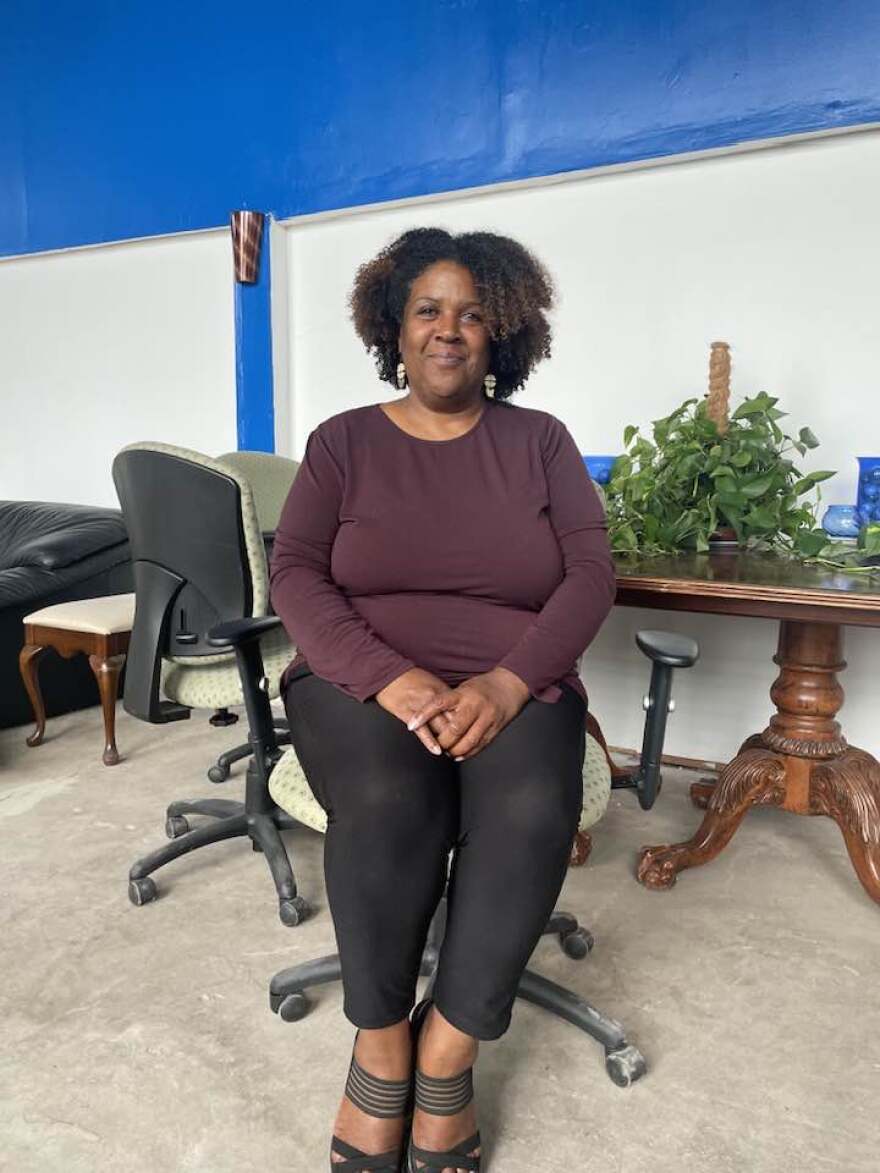Metro Detroit’s water and sewer infrastructure is a massive, sprawling underground world. And there’s one simple fact about it: The water flows down, from the northern suburbs to the lowest central point and “bottom of the bathtub”: Detroit.
That means that in our increasingly stormy climate, some areas are hit hard and repeatedly by flooding. But finding workable solutions for those neighborhoods is anything but easy – and nowhere more so than in a community on Detroit’s east side.
Jefferson Chalmers: “Money should be falling on us”
The web of underground pipes that carry billions of gallons of water every year sprawls out from the city of Detroit. Most of it flows back out through southwest Detroit, where the major sewage treatment plant is. And when a massive rainstorm overwhelms the system like it did in June 2021, sewage-filled water comes rushing down with astonishing force.
On the northeastern edge of Detroit, canals cut through a neighborhood that has long been defined by its waterfront identity: Jefferson Chalmers, one of Detroit’s most unique neighborhoods. It also sits just where a number of outlets for the region’s sewer system empty into the Detroit River.
It’s a neighborhood that’s experienced flooding for years. But the issue has become especially chronic and pressing since an August 2014 rainstorm that meteorologists characterized as an “unprecedented” once-in-every-500 years event – at least in the more stable climate of the past.
“If you look through the fence here, you'll see that on Jefferson Avenue, there are two gates, two pedestrian-sized gates,” Jay Juergensen told me as we stood beside a fenced-off Jefferson Chalmers canal. You could see the point where it ran under a culvert and headed underground. In 2021, sewage-filled stormwater rushed out of this and other outlets across Detroit’s east riverfront — and into surrounding basements.

Juergensen lives in Jefferson Chalmers, and owns additional properties around the neighborhood. He also heads up the Jefferson Chalmers WATER Project, a grassroots, citizen-led initiative to deal comprehensively with the neighborhood’s chronic flooding problems. In 2021, just days before another “unprecedented” rainstorm slammed Metro Detroit and this community in particular, the group released a white paper that laid out its vision for flood protection and mitigation on Detroit’s far east side — at an estimated cost of over $1 billion.
Juergensen knows that’s a huge ask, but also thinks it’s the right thing to do. “This neighborhood is being impacted by climate, and is an underserved community that has been impacted by climate over decades,” he said. “Money should be falling on us. We should not have to ask for it.”
That’s not to say there aren’t any efforts to address the chronic flooding here. But it’s complicated, because in 2021 the federal government also designated the neighborhood as a floodplain. And that brings up a whole other set of issues.
“Having the floodplain designation is a burden on the city. We can't invest like we would like in the city,” said Ken Kucel, a civil engineer in Detroit Mayor Mike Duggan’s office.
The issue is that once an area gets a floodplain designation, you can’t spend federal dollars there. It’s complicated, and there are a few loopholes and exceptions, but not many.
Combined sewer overflows and basement backups aren’t the only challenge facing Jefferson Chalmers either. When Great Lakes levels are up, like they were several years ago, there can be serious shoreline flooding.
Working with the U.S. Army Corps of Engineers, city officials came up with a plan to mitigate that: close off some of the neighborhood’s canals. But Kucel said that when they presented the plan to residents last year, the response was a firm “no.” “The community did not want to hear any part of any canal closure, permanent or temporary,” he said.
So Kucel said the city accepted that, and took a step back to reassess. “At that point we pressed pause on looking for a long-term solution to the flooding, and we decided to just take care of our own house first, if you will, by repairing the city-owned sea walls,” he said.
“We’re still back in the early stages [of] what other concepts might be out there to get to a permanent flood prevention solution.”
Gray vs. green
But fortifying those sea walls is a stopgap solution at best. That’s because most of the neighborhood’s sea walls are privately owned, and many residents can’t afford to upgrade theirs to new, more stringent standards.
But some residents like Jay Juergensen think the city and others aren’t thinking big enough about how to deal with our new climate reality. He said if the city did block off canals, it would limit residents’ ability to use the river — and create cesspools whenever combined sewer overflows happen.
Juergensen said they need to start thinking about taking water out of the system before it reaches the end of the line. “We have got to reduce demand,” he insisted. “We cannot build enough gray infrastructure fast enough to keep up with the impact of climate.”
When Juergensen says “gray infrastructure,” he means the usual big, concrete-and-steel infrastructure that has traditionally made up our sewer systems. So-called “green infrastructure” has a different approach: using landscape design and other means to take water out of the system, or slow it way down before it hits the pipes.
At Jefferson Chalmers’ Lakewood Park along the Detroit riverfront, Juergensen pointed out where shoreline restoration could help reduce flooding — by letting it return to what it once was. “We would like to see this park be returned to marshland,” he said. “It was a marsh before.”
In fact, all of Jefferson Chalmers – and the larger stretch of land along the Detroit River and adjacent Lake St. Clair – were once marshland, and Juergensen said it’s time to embrace that again. “Let's let this go back to a nature preserve,” he argued. “And have bike trails and walking trails and opportunities to interpret the flora and fauna that are here, and enjoy the parks and all the different ways that we could run them.”

There are some small green infrastructure projects and restoration efforts happening across Detroit’s east side. But the city has put most of its major green infrastructure so far on the west side, near the Rouge River.
City officials say they’re doing what they can with the resources they have, as they face the reality of a rapidly-changing climate.
“Everyone is working towards this,” said Sam Smalley, an engineer with the Detroit Water and Sewerage Department. “Are we doing everything we can? We're doing everything we reasonably can.”
Smalley said even if they had unlimited resources, it’s not an easy shift to make. “All of the engineering and design and sizing is all based on statistical analysis of what's happened in the past,” he said. “The future seems to be changing as we speak.”
“Just one headache after another”
Tracy Herron is another Jefferson Chalmers resident, who’s also been a realtor in the community for over 20 years. Her home has been hit repeatedly by basement flooding, and she’s also watched her neighbors struggle with it for years now.

Herron recalled one senior neighbor who just wants to move on and move out after repeated floods, but hasn’t been able to. “I think it's just wearing her down literally now,” Herron said.
But Herron added that flooding hasn’t had much impact on the neighborhood’s real estate market, at least until very recently. She remembered one client who “did get about three feet of water in his basement, and I thought it would cripple his chances of moving his [home],” she said. But, “We still sold it. It was still a hot item.”
Herron said that after living in Jefferson Chalmers for 30 years, she’s also thinking about moving on – and the repeated flooding is a big reason for that. “It’s just been one headache after another,” she said.
“It made us put our priorities together in perspective”
Immanuel Grace African Methodist Episcopal church is a small building tucked on the edge of Jefferson Chalmers, just a couple blocks from the river. On a recent Sunday morning, pastors Alfred and Michelle Baylor led the congregation in prayer.
The Baylors took over the church in 2018. In 2021, they were hit hard by flooding. The basement room they call their friendship hall was a total loss. The water rushed in with such force that it ripped a steel security door right off its hinges “like the Hulk,” Alfred Baylor told me. And it stopped just a couple stairs short of entering the sanctuary.

Michelle Baylor said that, coming on top of the COVID pandemic, forced them to take a step back and rethink their purpose and mission. “We just decided that we're going to slow walk it and serve the community,” she said. “It made us put our priorities together in perspective.”
Part of that mission is helping community members who’ve suffered repeated flooding. Michelle Baylor recalled a woman who went at least one winter without a furnace because she couldn’t afford to replace her flood-damaged one. Those are common stories in the neighborhood.

The Baylors also worry about how the lack of federal investment for things like subsidized housing will impact the community. Michelle said they fear it could become a place where only those who can afford to bear the cost of flood mitigation themselves will be able to live.
“How can we keep the neighborhood diverse, not just with race, but with socioeconomic status because of people born and raised here?” she wondered.
At the end of the day, the Baylors say what they want is simple — but also complex. “We want to see them do the right thing,” Michelle said. “We want to see them invest in lifting this neighborhood out of the floodplain, so it would be eligible for federal funds to bring it to the caliber of neighborhood that we know it can be.”
Jay Juergensen had a somewhat different take. “If we do not solve our infrastructure problems, our neighborhood will go the way of the dinosaurs,” he said. “It will disappear.”







